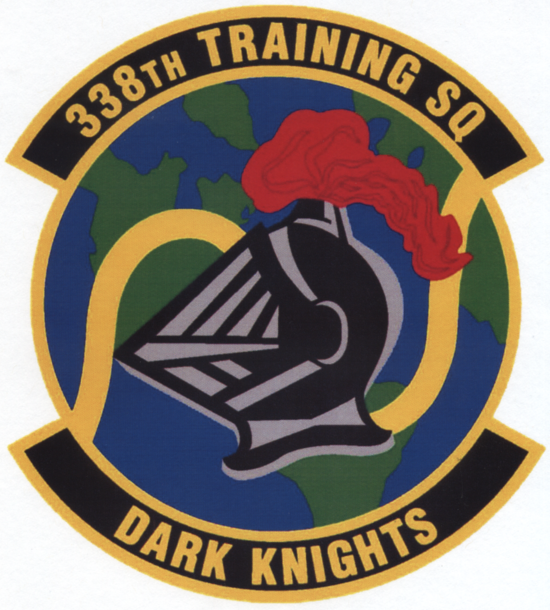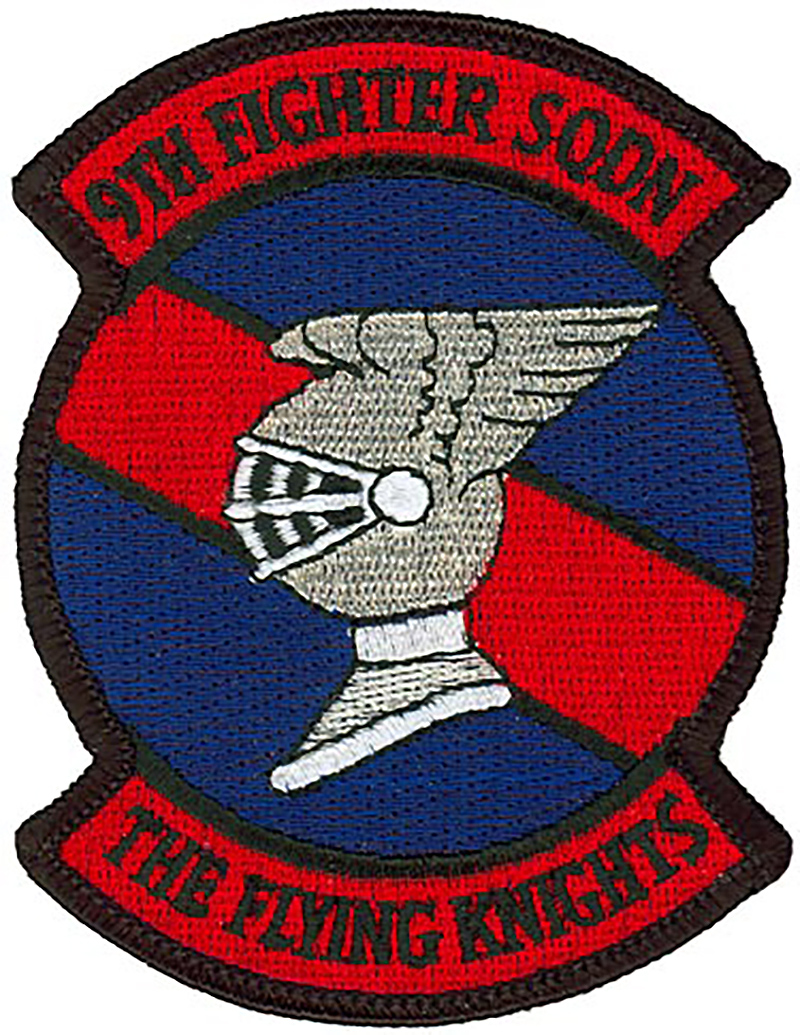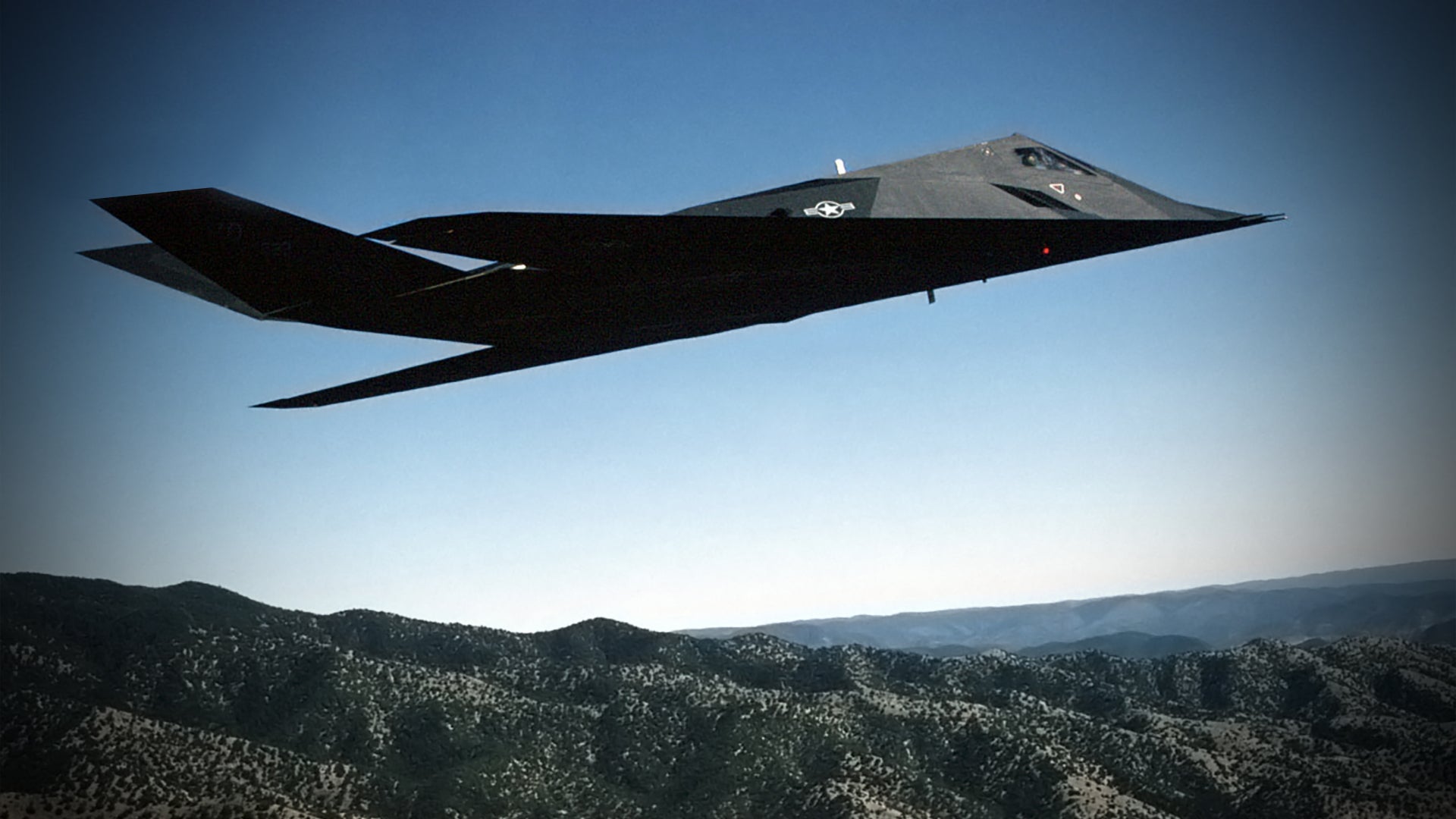Yet another new tidbit of information has emerged regarding recent F-117 Nighthawk operations over and around Panamint Valley, California. Photos from the aircraft’s famous appearance near the aviation photographer haven of Rainbow Canyon have shown the black jets largely stripped of markings, aside from one peculiar and high-profile addition on one of the planes—a color tail stripe prominently displayed on the F-117’s ‘v’ tails. It reads “Dark Knights” and has the iconic planform shape of an F-117 towards the tail’s leading edge.
The first generation stealth jets were officially retired over a decade ago, but the type is still flying in small numbers. You can read all of our years of coverage on the F-117 and the fascinating topic of its continued operation here. Most recently, it was reported that some of the Nighthawks had been returned to operational service to fly combat operations in the Middle East—a claim we broke down in detail in two special features linked here and here. So, suffice it to say that the appearance of the mysterious tail flash only adds to the intrigue surrounding the stealth jet and its ongoing flight operations.
The shot showing the tail band can be seen in the photo in the tweet below. Higher resolution photos can be seen on Air Forces Monthly website linked in the tweet and here.
Let’s start with the name. Dark Knights would certainly be a great name even for the small cadre of pilots and maintainers that are known to keep roughly four to six F-117s flyable at any given time at the mothballed force’s home, Tonopah Test Range Airport. The “dark” part of the name could likely signify the shadowy nature of the unit’s existence—the USAF has elected to stay bizarrely quiet about the status of its F-117s since the type’s official retirement and banishment to the high-security airfield in a very remote part of the Nevada desert.
Dark Knights also has a pop culture connection. Arguably the most beloved Batman movie ever used the Caped Crusader’s nickname “Dark Knight” in its title. Batman, a vigilante that takes on his enemies alone in the dead of night while wearing a black suit of armor certainly sounds like a good fit for the F-117 and its mission set.
There is also already a Dark Knights squadron in the USAF. 338th Training Squadron is based at Keelser AFB and is part of Air Education Training Command. According to the Keesler AFB’s webpage, the unit trains airmen in “RF transmission, airfield systems, ground radar, cyber transport.” The existence of this very public unit is interesting, but it doesn’t appear to have any relation to the F-117 or its continued flying operations.

The Knight moniker also has a historical relation to the F-117 program overall. In 1993, as F-117 operations relocated to Holloman AFB in New Mexico, the 9th Fighter Squadron, known by the nickname “Iron Knights,” took over F-117 operations from the 415th Fighter Squadron. That unit had flown the F-117 during the tail-end of its period of the program’s secrecy from the type’s initial operational home at Tonopah Test Range Airport, through declassification, and on to incredible success during Operation Desert Storm. The 9th Fighter Squadron was one of just two operational F-117 squadrons following the type’s bedding down at Holloman AFB.
Apparently, sometime in the second half of the 1990s, the 9th Fighter Squadron changed its nickname from “Iron Knights” to “Flying Knights.” Regardless, the Knight nickname has a special place in F-117 lore and history.

Some may say the appearance of the tail flash flown on a jet with nearly all its other markings sprayed over seems indicative that a new squadron, possibly one with greater manpower and capabilities than the skeleton crew that has kept a handful of F-117s flying for years, has been established. But really, it’s all anyone’s guess. As we noted in our piece on the F-117 Middle East deployment rumors, there is no real evidence to support such claims nor the existence of a F-117 combat force of any size, although there may—or may not—have been a real requirement and clear logic behind secretly returning a number of F-117s back to operational service.
What’s more likely is that the markings just highlight what has existed for many years—the name of the unit tasked with keeping F-117s airborne for test and currency purposes and with maintaining the dozens of airframes cocooned five to a hangar at Tonopah. You are probably wondering why a jet that isn’t supposed to be seen have a tail flash? The answer is likely morale, at least mainly. But once again, we just don’t know what the exact circumstances and origins are behind badging.
It’s also worth noting something we have pointed out time and again, that these aircraft could very well be operated by contractors, not the USAF. This is actually something we have been told multiple times in the past and it would make a lot of sense. As such, slapping a non-standard decal of the contractor unit’s chosen nickname on one of the F-117’s tails seems far less puzzling than the alternative explanation.
Still, in retrospect, there were signs that the Knight name was associated with ongoing F-117 operations of a semi-clandestine nature for a long time. The callsign “Knight” has been used for years by F-117s flying sorties over the Nellis Test and Training Range complex. Up until just a few weeks ago, nobody had ever seen one operate outside of that desolate expanse post retirement. But now the aircraft are remarkably active, and even interactive with aviation photographers in Panamint Valley.
The video below is from our friend Jamie Hunter—the boss of the always wonderful Combat Aircraft magazine—who was just in Panamint Valley to look into the recent sightings.

In the video, firsthand witnesses talk about how the jet flew up and down Panamint Valley while F-16s orbited at the opposite ends on the jet’s racetrack pattern. The F-117s were photographed without their radar reflective devices installed and have repeated the mission a number of times in recent days.
This sounds a lot like sensor testing with the F-16s using onboard radars and/or infrared search and track systems to gauge their performance against the best low-observable control variable the USAF has—the F-117. Back in 2014, I wrote the following as part of an large piece that speculated on why the F-117s were still flying:
At the time of the F-117s official retirement, and its subsequent banishment to tomb-like hangars deep in the Nevada Desert, the aircraft was the most understood low observable platform in the history of aeronautics. Hundreds of thousands of hours were flown on the fleet of 64 aircraft (including pre-production versions), crashes were deeply investigated and improvements on the effectiveness of the aircraft were constantly being made.
In other words, the F-117 is a known commodity to the DoD and the USAF, and this is especially true when it comes to the aircraft’s unique radar, radio, and infrared signature. In fact, I would not be surprised if the F-117 represents the most studied aircraft “signature” of all time. With this in mind, the F-117 could be theoretically used as something of a “flying measuring stick” for evaluating a radar system’s ability to detect and track low-observable flying objects. Or conversely, it could be used as a surrogate to test new radar absorbent materials and coatings applied to its flat, facet like structure that was originally built to accept such applications.
By specifically utilizing the F-117 for such-real life tests and evaluations, defense program managers could have a control variable, in this case the F-117′s well documented radar cross-section, infrared, and visual signature, and an independent variable for which to test upon it. That independent variable being an experimental radar absorbent material or other signature control application.
Testers of new signature control applications, such as an innovative new version of radar absorbent material (RAM), could leverage highly accurate real-life metrics and historical data collected throughout the life and development of the F-117. They can then fly their new application on the jet so that new data can be collected for which to compare and help judge the effectiveness of the experimental capability being tested.
On the radar and infrared tracking side of argument, the F-117 is also a near-perfect and highly available low observable aircraft to test everything from ground based radars and SAM systems—both foreign and domestic—AWACS modifications, fighter radars and even infrared search and track systems.
By doing so, testers can come up with a clear idea of what the capabilities of the system being tested are against a hard to detect target. In doing so, tacticians can work on solutions for defeating any weaknesses in the system while at the same time working on emphasizing its unique strengths. Even keeping a couple “sterile” F-117s available for calibrating and improving the DYCOMS array at Groom Lake, used for measuring the radar cross sections of aircraft flying under real world conditions, may be in itself an entirely necessary and worthwhile reason to keep a small cadre of F-117s operational.
The trough-like valley with a relatively smooth and flat floor offers a remarkably good backdrop for testing detection and tracking of such a stealthy target flying at low-level against uniform ground clutter. It is also electromagnetic emissions quiet area, which can be beneficial for radar testing.

We know for a fact that testing of advanced IRST systems is deeply underway. The F-15C/D and Super Hornet Forces are slated to get these sensors en masse soon. America’s enemies also use the technology for passive detection of airborne targets, which is totally immune to a stealthy plane’s small radar signature. In fact, we know an F-16 that flies test support out of Groom Lake/Area-51 is outfitted with the same IRST sensor intended for the Super Hornets and the Eagles. That aircraft was also caught on camera very near where the F-117 was, but it was blasting through “Star Wars Canyon.”
The F-117 was designed specifically for reduced infrared signature. Its elaborate planar exhaust system spreads out and attenuates the jet’s twin GE-F404 engines’ thermal signature. This makes it a very attractive and challenging target for testing the abilities and limits of IRST sensors.
New modular Active Electronically Scanned Array (AESA) radar systems are also being tested for a number of tactical jets and bombers, and the F-16, in particular. So the low-level profile the F-117s were flying, the location of the flights, and the positioning relationship with the F-16s makes a near perfect sense in regards to air-to-air sensor testing.
Some final thoughts—it’s odd that the USAF remains so secretive about the four decades old F-117 force, but at the same time its pilots clearly aren’t shy about posing for cameras. Now we know that some of their aircraft even sport very visible and intriguing tail flashes. Clearly, the Dark Knights would have an amazing story to tell, one that likely includes keeping one of the most iconic, historic, and exotic flying war machines operating in the shadows over a decade after their collective flying fate was supposedly sealed.
Now that the USAF is disposing of the F-117s at a rate of four per year, maybe we will finally hear their story sooner rather than later.
Contact the author: Tyler@thedrive.com
